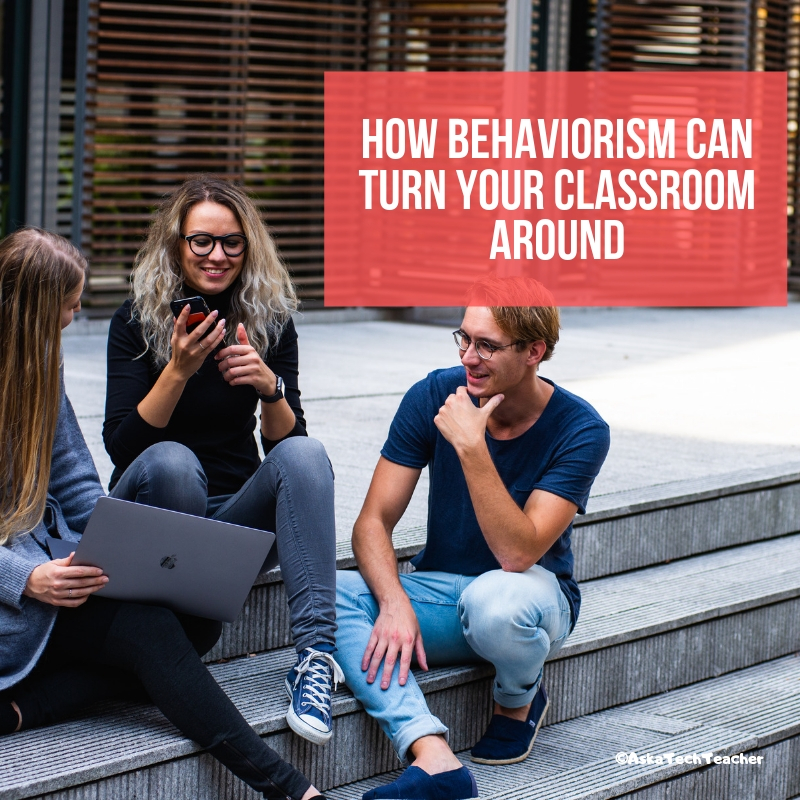In my summer digital citizenship classes, the biggest question I get is how to control student cell phone usage. Luckily, Ask a Tech Teacher contributor, Andrew Carroll, former High School teacher, has a great analysis of the problem and discussion of solutions below:
How to control smartphone usage in classroom?
Shoulders slouched and eyes down—you guessed it right! It’s a smartphone that your students are using.
Digital devices, especially smartphones and tablets, have become an appendage for schools. In the presence of a smartphone, children don’t pay attention to the lesson being taught. Instead, they would rather stick their heads into their smartphones and stay glued to social media or texting their friends.
But it is not their fault. In a time where digital devices are ever-present, it is difficult for kids to not be influenced by them. Smartphone are making it impossible for our children to focus on anything else, least of all their studies. And it has adverse effects on their health as well. We are all aware of the negative impacts of smartphones. It is known for causing depression and anxiety among adults and children alike. Owning a smartphone may make students prone to cyberbullies, which can bring its own trauma.
In a classroom, on average, children check on their phones 11 times a day. Distractions from cell phone cause students to get behind lessons and ultimately get poor grades. Text messaging between students, in a classroom, disturbs the atmosphere. Like a ripple effect, one student using a cell phone disturbs other students as well. This leads to inattentiveness and lack of class participation. Hence, some students are left way behind than others.
What various techniques can be used?
It is a challenge for teachers to control and regulate the use of smartphones in a classroom. Using a digital device for educational purposes should be encouraged. However, the use of devices for other purposes should be restricted.
Many teachers have a phone jail system, where students submit their phones before class and collect them when it ends. While this may work for one class, it does not solve the underlying problem, which is the overuse of smartphones in class.
According to this article, a professor at the University of Colorado Boulder gave points to college students for submitting their phones before class. The professor found out that it helped in engaging the students more effectively. Incentivizing the desired action encourages students to comply with certain rules, but many say that it does not address the underlying problem of student’s addiction to smartphones.
The examples given above are not complete solutions. Although they seem to remove cell phones from the classroom altogether, they do not prevent students from overusing it at other times. When students have to forcefully submit their phones, it often creates resentment and anger against the teacher. It can also discourage students from coming to class. The second example saw, students willingly giving up their phone, however, it does not solve the problem of why students are distracted.
According to some individuals, simply banning cell phone in schools wouldn’t solve the problem. On average, a college student checks a phone every 15-20 minutes. Recent studies have suggested that people experience withdrawal symptoms in the absence of a phone. It can have a negative impact and even induce anxiety and stress among individuals. Imagine what would happen when students have to go without a phone for an entire day! Moreover, parents feel assured that their kids are safe, knowing that they can contact them during any hour of the day.
What are other countries doing?
The distractions that cell phones cause during class is a problem faced by teachers all around the world. Educational institutions in places such as France, Canada, UK, and Australia are addressing this problem by banning cell phones altogether. It raises the question of whether enforcing this ban will have a positive effect on student’s learning or not.
Secondary and middle schools in Ontario, Canada, are banning the use of cell phones during classes effective from September 2019. In July 2018, the French government banned cell phones from classrooms. Similarly, last year in September, Australia banned phones from schools as well.
The ongoing debate between banning and allowing cell phones in class puts forward both the positive and negative aspects of the technology. On the one hand, it serves as a distraction, while it can also serve as an educational resource. Whatever way the argument skews, one thing is for sure: schools need to come up with policies to address this issue. Banning the device may seem like the right solution for some. According to research, a ban on phone in the classroom improved the test score by 6.41%. Evidence suggests that these gains are manifested only when the ban is complied with. The research found out that underperforming students were able to benefit the most from this ban.
Another research discovered that without a cell phone, students were able to take more detailed notes, retain more information, and wrote down 62% of the information delivered during class. Students without a phone were able to improve their grades by a full letter grade and a half. These achievements in students’ performance compels one to think that removing a cell phone from the classroom is the solution. In 2017, a study was conducted which states that even when a smartphone is not in use, its presence can reduce available cognitive capacity.
However, we should also take into account the fallacies in the current school system. Our educational institutions have not coped up with the technological advances of current years. If we were to equip students with knowledge of modern technology, it is imperative that such devices, including smartphones, become a part of the curriculum. But this needs to be in moderation. Too much use and it can cause a disruptive class. Too little use and we have students without awareness of modern technology.
There is an alternative to this. The key to solving the issue of cell phone usage in a classroom is knowing what distracts kids. To do so, there are monitoring apps for digital devices. You can monitor a student’s smartphone activity using cell phone monitoring applications such as Xnspy for schools. Although there isn’t any cell phone monitoring device for teachers, parental control apps can be used by teachers (by bringing parents on board) to keep their students in check.
How can parents solve this problem?
For a documentary, Screenager: Growing up on in the Digital Age, a survey was conducted which had more than 1,200 parents of middle school students as respondents. According to the survey, 55% of parents said that their children owned a cell phone. While more than 80% of the respondents did not want their children to take their phone to school.
It’s about time that parents realize that giving a child access to a smartphone makes it worse for the child to pay attention in class. There is a need for parent-teacher dialogue on regulating the use of smartphones inside and outside the classroom. Since parents are the guardians of their kids, it is their duty to exert control over their children’s smartphone usage. Moreover, parents need to discourage their children from bringing smartphones to the school in the first place. Alongside this, parents should moderate the use of smartphone in their children.
However, this does not resolve teachers from their duties to keep their classroom in check. The reason why so many children would rather use their phone in a classroom could be because they have no interest in the subject or are behind their peers. Therefore, teachers need to be vigilant in ensuring that their students grasp the concepts being taught. They need to make their lesson plans more engaging that allow students to show an interest. Teachers may even have to incorporate the use of smartphones to increase student attention in the subject.
Whether banning a cell phone or not is an ongoing debate. Teachers, parents, and administrators need to come together to introduce policies that find a balance.
Author Bio:
Andrew Carroll is a former high school social studies teacher. He taught for eight and a half years at Oxford Hills Comprehensive High School in South Paris, ME. During that time he piloted 1:1 laptop use before the program went school-wide. He coordinated a “laptop squad” to support teachers’ use of laptops in their classrooms. He also served on a number of curriculum and assessment committees. His work is focused on sharing free web-based resources that educators can use to enhance their students’ learning experiences.
More on digital devices
How Wearable Technology is Changing Education and Easing Disabilities
Best-Kept Secrets for Teaching Tech to Kids
Jacqui Murray has been teaching K-18 technology for 30 years. She is the editor/author of over a hundred tech ed resources including a K-12 technology curriculum, K-8 keyboard curriculum, K-8 Digital Citizenship curriculum. She is an adjunct professor in tech ed, Master Teacher, webmaster for four blogs, an Amazon Vine Voice, CSTA presentation reviewer, freelance journalist on tech ed topics, contributor to NEA Today, and author of the tech thrillers, To Hunt a Sub and Twenty-four Days. You can find her resources at Structured Learning.






































1 thought on “Smartphones in the classroom”
Comments are closed.